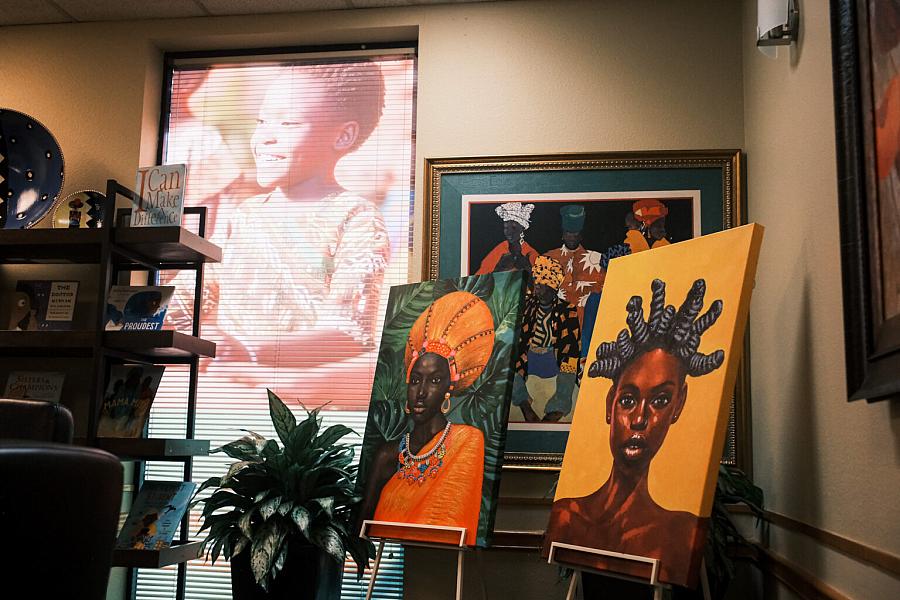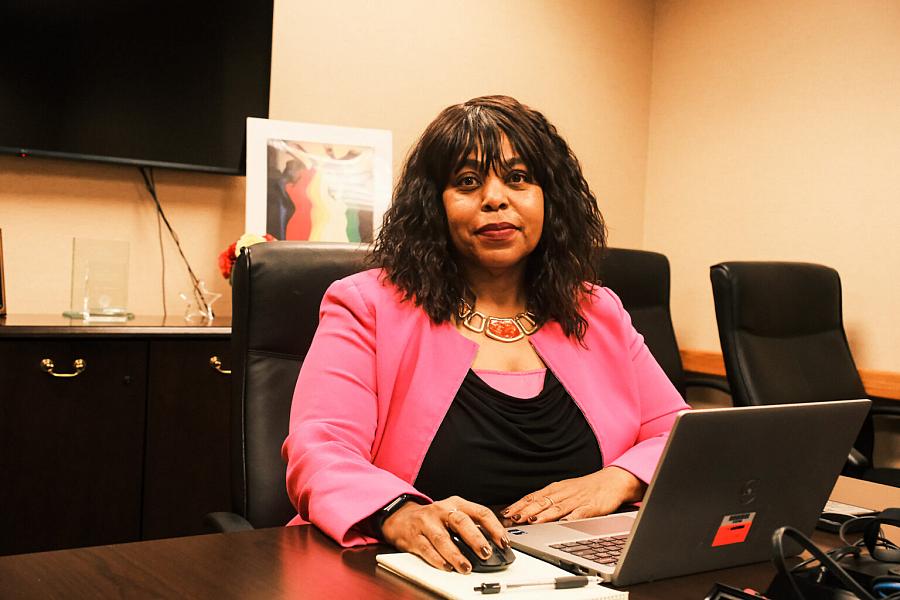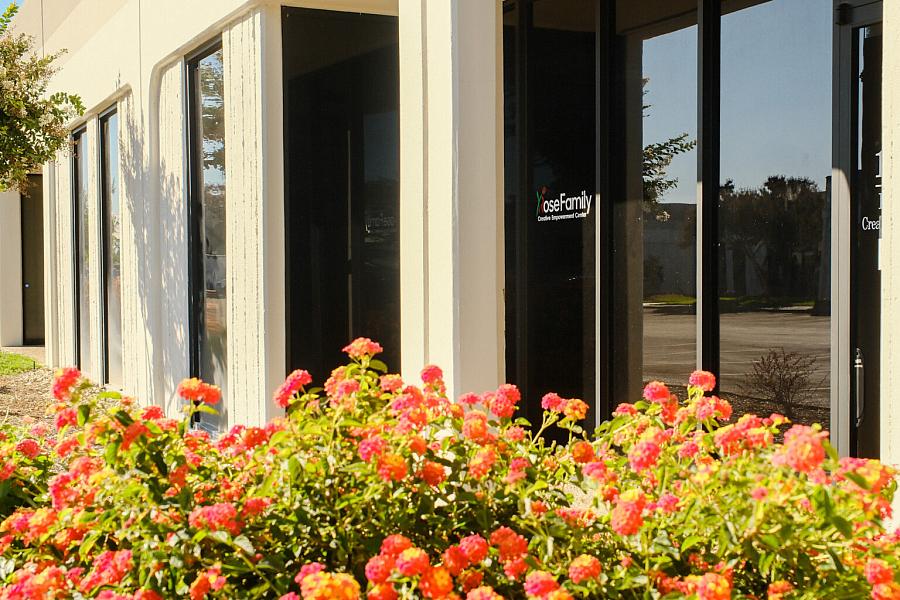Federal funding uncertain for a program that keeps Black kids out of foster care
The article was originally published in AfroLA with support from our 2025 California Health Equity Fellowship.

Rose Family Creative Empowerment Center runs community events in this space at their headquarters.
(Ruth Finch for AfroLA)
Latazia Allen had just given birth to her first son, the youngest of five, when Sacramento County child welfare officials took him away in 2023.
A week earlier, Allen was assaulted by the father of her children in a motel parking lot. Allen, then nine months pregnant, and her 2-year-old daughter were harmed, she said, and a witness called Child Protective Services.
A few days later, settled into a domestic violence shelter, Allen remembers a CPS investigator paying her a visit. The woman encouraged Allen to obtain a protective order. Allen trekked to the courthouse the next day to file the paperwork. Her water broke while she was in line waiting. At the hospital, she texted the father to let him know their son had been born.
She returned to the shelter with her newborn, but shortly afterwards, a social worker showed up to remove her infant and her 2-year-old daughter. Allen said she was in the middle of breastfeeding her newborn when the social worker took him “off my grip.”
“I felt like it wasn’t fair,” said Allen, 28. “I felt like they weren’t caring to understand where I was coming from.”
That’s when Yolanda Stevenson stepped in. Stevenson is a cultural broker with Rose Family Creative Empowerment Center, one of three organizations contracted by the County to specifically help Black families.

Rose Family Creative Empowerment Center is a contracted agency for the Cultural Broker Program in Sacramento County.
(Ruth Finch for AfroLA)
For cases like Allen’s, Stevenson’s job is to help families navigate their CPS case. Sitting in on meetings with social workers, Stevenson might stop the proceedings to define acronyms for the parent in the room. Or if a social worker is insisting a parent meet certain requirements, she’s the person in the room asking, “Why?”
“Sometimes culturally, because we’re so afraid that if anything we say is gonna be used against us, we don’t ask questions,” Stevenson said.
Stevenson, who is also a program manager and director of social services at Rose Family, said Allen’s case was complicated by a history of drug use. The process to get her kids back took months, and included weekly visits with her children for one hour. After the first visit, her County social worker told her they would have to cancel the visits if she kept crying.
“She was referred to a cultural broker because the relationship between her and her child’s father and the social worker was not healthy,” Stevenson said. “The trust and communication” weren’t there. When foster parents looking after her children said they wanted to adopt her newborn son, Allen started to panic. Allen, who grew up in foster care, said she stopped sleeping and eating and lost a lot of weight.
“I was hoping and praying that the judge gave us a chance to fight for our children because I didn’t want them being split up,” she said.
In the last 25 years, Sacramento County has managed to lower the number of Black children in foster care by 86%. For white children, that figure is 88%. Despite lower numbers of Black children in foster care, Black kids are still overrepresented. According to the most recent data available from the Child Welfare Indicators Project, 34% of children in foster care in July were Black, the largest share of any racial or ethnic group. That percentage hasn’t budged much in more than two decades: In 2000, it was 36%.
Sacramento County child welfare officials think the cultural broker program can help. Introduced in 2017, cultural brokers mediate between Sacramento County child welfare officials and the families they have the power to separate. The goal is to keep families together and prevent Black children from entering foster care.

Melissa Lloyd is the deputy director of CPS in Sacramento County.
(Ruth Finch for AfroLA)
“A broker can literally make the difference between something escalating into a removal” and a family cooperating with a social worker, said Melissa Lloyd, CPS deputy director within Sacramento County’s Department of Child, Family and Adult Services.
According to numbers provided by the County, from 2018 through 2023, 552 families were referred to cultural broker services, said Kim Pearson, who oversees the Sacramento County Cultural Broker Program. Out of those families, 90% had their case closed “successfully,” meaning the children were reunified with their biological parents, adopted or placed in a permanent living arrangement.
But the program is “severely underfunded,” Pearson said. In their quest for funding, CPS is going after special federal dollars from a 2018 law that could keep the program afloat indefinitely. But first, they have to figure out how to acquire the money.

Kim Pearson oversees the Cultural Broker Program in Sacramento County.
(Ruth Finch for AfroLA)
The path to qualify for funding will likely be long and arduous, and involve multiple studies, one of which has already cost hundreds of thousands of dollars. But for Black families who are overrepresented in the child welfare system, the need for programs tailored to them is paramount.
Stevenson worked with multiple social workers to advocate for Allen. Eight months later, Allen was reunited with her infant son and daughter. Both Allen and Stevenson believe her children would not be with her today if not for the cultural broker program.
“My cultural broker basically had to keep my faith and my hopes high. It was really, really hard,” Allen said.
Listening to the data
“What we’ve had to tackle in Sacramento County is really taking time to understand what the data is telling us, and then just, quite honestly, owning it,” said Lloyd. “We were bringing in far more African American families into our system. Kids were staying longer in care.”
The data says a lot. Maltreatment allegations among Black children in Sacramento County have hovered around 26% since 2000. Last year, 30% of children who entered foster care were Black, despite Black people being just 10% of the County’s population. That’s almost double the number of Black children across the state going into foster care, which is 18%.
Over time, these outcomes have bred a lot of distrust between CPS and Black families in Sacramento. That’s where the cultural brokers come in. With their direct knowledge of Black cultural values and beliefs, the idea is that they can help bridge trust. For this reason, cultural brokers are not government employees. Instead, CPS contracts with community organizations like Rose Family, which has existing relationships with people who live in the neighborhoods they serve.
Cultural brokers receive more than 80 hours of training, including 40 hours of the same training social workers go through. They’re allowed to access CPS family case files, and they attend regular check-in meetings to weigh in on the care of kids alongside experts, their social workers and caregivers – foster parents, relatives and biological parents.
Currently, there are eight active cultural brokers across the county. At Rose Family, they meet with CPS officials twice a month to review cases. They’re paid between $18 and $23 an hour.
Brokers work with families from the time a CPS referral is made until the case is closed. In some cases, they meet families in their homes. In these instances, brokers might instruct the family about how to create a safer environment for children. Infant mortality is highest among Black children in the County, so cultural brokers provide cribs and training for parents to help them baby-proof their home.
So far, more than 1,000 referrals have been made to the program. As of July last year, 842 families had received services from a cultural broker.
“We’re all human, we all have a perspective and a lens. But if you’re not open to see another person or respect another person’s cultural lens, then you can come with your own judgments,” she said.

Rose Family Creative Empowerment Center is a contracted agency for the Cultural Broker Program in Sacramento County.
(Ruth Finch for AfroLA)
Officials are banking on the cultural broker program to help Sacramento curb the high rate of Black children entering the child welfare system. So far, the County has directed $500,000 a year to support the program. They have also secured a grant from the U.S. Department of Justice, but that money is restricted to helping families entering the child welfare system because of drug-related allegations.
The funding Lloyd and her team are looking for could come from the Family First Prevention Services Act (FFPSA). Passed in 2018, the federal law changed the way foster care is funded across the country. For the first time, states can use federal money to help families before their children are taken from them.
But to get the money, Lloyd and her team have to compile enough data, research study results and evidence to show the program works and meets federal clearinghouse requirements. This process will take years, hundreds of thousands of dollars — and there is no guarantee of success.
The approval process
Here’s how it works.
In order for any prevention program to qualify for the federal money, it needs to be approved by a clearinghouse run by the Children’s Bureau, part of the U.S. Administration for Children and Families. The clearinghouse has three ratings that make a program eligible: promising, supported, and well-supported.
But before Sacramento CPS can submit the program for a rating, they are paying an outside agency about $350,000 to determine if the program is even ready for review, Pearson said.
The County will need enough data to prove that the program is effective at keeping children with their families. To do this, officials are preparing a study comparing families that received cultural broker services to those who did not, Pearson said. County workers are putting in extra hours – not covered by the grant – to create surveys for family court staff and to identify past and current participants of the cultural broker program. A group of parents formed an advisory board that assembled last year to provide feedback on the program.
“It gets so complicated with the clearinghouse to meet their threshold,” said Karen Parker, who heads the implementation of the FFPS program in Sacramento County. “Every family is unique. You could give two families a broker, and one could succeed and one couldn’t.”
Officials should know by summer 2026 if the program is ready for a clearinghouse review. If it’s not, additional work – and money – might be needed to get it there. Other programs have needed up to a decade to prepare for a review by the clearinghouse.
One-time FFPS program grants to states to pilot programs like cultural brokers is funding the prep work for review. All of the grant money available to California counties has been dispersed, officials said, meaning Sacramento doesn’t have a surefire way of paying for additional work.
County child welfare officials, like Pearson, say they believe the cultural broker program is worth the expense. Those who control federal dollars want them to prove it.
“In the Black community, a lot of times [evidence-based] practices are not aligned with the people who live in the community,” said Pearson. “It might be evidence-based practice, but evidence-based practice for who?”

Rose Family Creative Empowerment Center operates community programs in South Sacramento.
(Ruth Finch for AfroLA)
California confusion
In 2021, California opted into the FFPS program, which gives the state money — and control — to fund programs proven to prevent children from entering foster care. As part of its agreement with the federal government, California created a list of programs that can receive funding.
Of the 10 programs California chose, none are designed specifically for families of color, like cultural brokers. Instead, these programs are “more traditional Western models,” said Sean Hughes, a consultant who is helping counties implement the program.
California has further complicated the quest for funding by restricting counties to programs that receive the clearinghouse’s top “well-supported” designation. The federal government already requires that at least half of the programs states choose have “well-supported” ratings to qualify for money.
These “well-supported” programs are cheaper for states to implement, requiring fewer reviews than programs with lower ratings, said Kathryn Icenhower, a child welfare advocate who sits on multiple state committees steering the state’s prevention efforts, including the Child Welfare Council.
Many programs that have “well-supported” ratings in the clearinghouse already have decades of research and studies on hand for an evaluation.
In a written statement California Department of Social Services spokesperson Jason Montiel said that the programs the state selected were chosen based on a survey distributed to child welfare agencies across California. The programs, Montiel said, “were identified as those that met the needs of local populations.”
Montiel said counties can use the one-time grant dollars to fund “culturally based prevention services” that the state did not include on its list. However, all of this grant funding has been allocated already, according to Hughes..
By credentialing their program with the federal clearinghouse, Lloyd and her team hope other California counties can receive federal money to use the cultural broker model. In Los Angeles County, child welfare officials are assessing their own cultural broker program for Black families in the quest for a clearinghouse rating, using the same one-time grant funding as Sacramento County.
Clearinghouse approval also opens the door to more funding, not just from the government, but also from private funders, Pearson said.
Pearson said Sacramento County ultimately hopes to make cultural brokers available to families of other cultures.
“We see the outcomes and the benefits,” she said. “CPS is a huge system. For anyone to have someone to help them navigate our system, that would be ideal.”
If the day comes that Sacramento’s cultural broker program is rated “well-supported” in the federal clearinghouse California will have to officially amend its list of programs to allow counties to receive money for it. But that’s unlikely under the Trump administration, which has slashed or stopped funding for programs that address diversity, equity and inclusion.
“As a human being, if anybody’s children was ripped from their arms, there’s going to be emotional feelings,” said Stevenson. Parents aren’t always going to want to work with a social worker when this happens – and that’s to be expected. “That’s where we come in.”

